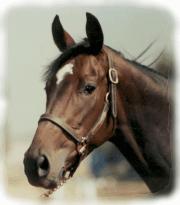A Horse, of Course with Don Blazer |
If you enjoy learning about horses, then you'll love our online courses. Each month you'll find a new column on our web site. We hope you'll enjoy it, and maybe e-mail us with questions or suggestions for other columns. A Horse, Of Course is a monthly column syndicated by Success Is Easy. If you like the column, call your local newspaper, or local horse publication and ask them to subscribe by contacting Success Is Easy. |
Horse Gaits and Footfall Sequence Don Blazer copyright©2011 What are horses good for? When man first met the horse, he thought the horse was good for "eatin'." But he soon discovered every time he tried to catch a bite, the horse was best for "movin'." Horses and mankind have been doin' a lot of movin' together for the past 5,000 years, and yet, amazingly, few horse lovers actually know how a horse moves. Sure, he puts one foot in front of the other. Sure the muscles move the bones, but what we need to know as riders is how them bones gonna move and where. Believe it or not, the majority of horse owners and riders cannot tell you the footfall sequence of a horse at the walk, trot or canter, or the walk, jog or lope. There is a difference between the styles, not in footfall, but in foot flight. The jog and lope are western gaits in which the flight of the foot travels a more rounded arc and the horse covers less ground moving forward. This is because the western horseman wants to move cattle along slowly so he doesn't run all the fat off the cow and all the money out of the bank. The trot and canter are what we in the US call English gaits. The flight of the foot is much more natural and follows a longer, lower path. The English rider doesn't care about fat cows, she just wants to catch the quick brown fox. The most common error about how horses move is in thinking the begins walking by moving a front foot. He does not. Actually a hind foot (which hasn't yet come off the ground) has to push the horse forward so that he loses his balance and reaches forward with a front leg to catch himself and reestablish his equilibrium. The sequence of strides for a walk, for example, might be left hind, left fore, right hind, right fore. Watching the horse, you'll see the left front foot lift off the ground even though the left hind hasn't left the ground yet. Still it is the left hind which is in action first, pushing the horse out of balance. The left front foot is moving forward ahead of the left hind because the left hind foot is going to over-stride the hoof print of the left fore. The left fore must get out of the way of the left hind or it will be struck (forging) or it could "scalp" the coronet band of the hind foot. The trot is a two-beat diagonal gait. All action is initiated in the hindquarters, so the left hind and right for move together, followed by the right hind and left fore. There is a moment of suspension in the correct trot movement. There is no over-stride in the trot, so the horse must shorten his body and elevate the flight of the foot. The trot has good extension, while the jog has very short forward movement. The lope or canter is a three-beat gait in which one side of the horse's body is extended (the leading side) and the other side is contracted (the pushing side). The sequence of strides for the left lead begins with the right hind foot which takes a short (pushing) stride. The left hind and right fore move together. The left hind is in an extended stride while the right fore is in a shorter stride. The final stride is the left fore-foot which moves on a long stride. Gaited horses essentially walk and canter…but do not trot. A Missouri Fox Trotter, for example, does not trot, but instead walks rapidly. The fastest gaited horse is a "single footer" who walks so fast that he can have a "single foot" on the ground at a time. Knowing which foot is on the ground and when is important for two reasons. If the hind foot is grounded and the rider applies leg pressure, the horse will drive forward. If the hind foot is off the ground and the rider applies leg pressure on that side, the horse will elevate the foot. Secondly, the rider needs to know the footfall sequence for all the maneuvers at horse can perform so she correctly asked the horse to place his feet. When a rider doesn't know the correct footfall sequence for maneuvers, the horse is restricted, hindered, thrown off balance and has the skeletal and muscle systems unnecessarily stressed. The result: instead of good movin', injuries! |
